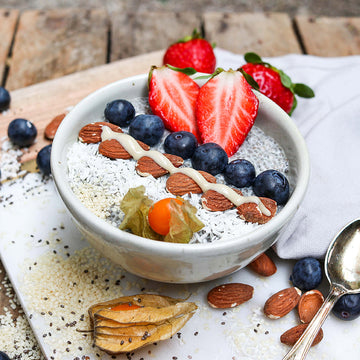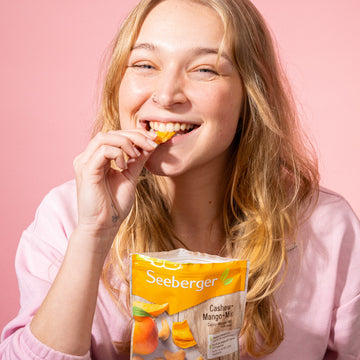

Vitamins are the stars of our diet
...but also the subject of many questions, myths and truisms. But the topic is not that difficult. A few basics are enough to help you see through the jungle of supposedly vital information, recommendations and warnings. We explain which vitamins your body really needs to be healthy and ready for action.
Disclaimer: We do not provide medical advice. This article is purely a source of information and provides a rough overview of the topic. For specific information and in case of problems, please contact experts. Nutritionists or doctors can help you here.

The 1x1 of vitamins
Hold my Orangejuice, let's start with the basics: The two major classes of vitamins and the responsibilities of each vitamin group in your body.
Fat-soluble and water-soluble vitamins
The body cannot utilize and absorb fat-soluble vitamins (vitamins A, D, E and K) without dietary fats. In good times, it stores them in fat deposits and releases them again when needed. The best way to absorb these vitamins is with high-fat foods: All kinds of nuts, avocados and salads with oil dressing are ideal here.
In contrast, other vitamins (such as the B and C vitamins) are water-soluble. You don't need fat to utilize them, but they are also not stored in the body. To keep your vitamin balance on point in the long term, you therefore need to regularly consume water-soluble vitamins in your diet.

Vitamins: The all-round caretakers
If you're smart, you can get help. And our body can't do everything on its own. That's why it brings many little experts into the house - all with their own special tasks:
Vitamin A: A fat-soluble vitamin that supports your vision, immune system and cell growth.
- Occurrence: In many orange-colored vegetables such as carrot, sweet potato and pumpkin. Also found in leafy vegetables such as kale and spinach.
B-complex: The umbrella term for various water-soluble B vitamins (B1, B2, B3, B5, B6, B7, B9 and B12). They are essential for your nervous system, your energy balance and your metabolism.
- Occurrence: e.g. in walnuts, cashews, pulses, but also in many animal foods such as salmon, dairy products and eggs.
Vitamin C: Do you immediately think of oranges and lemons? The water-soluble vitamin C is known for its role in the immune system, in wound healing and for its antioxidant effect. Vitamin C is also important for collagen production - which you need for firm skin and resilient joints, for example.
- Occurrence: Citrus fruits of any kind, of course, but red peppers, broccoli and Brussels sprouts also score highly with the big C.
Vitamin D: Without D, there is no dentin! This fat-soluble vitamin group is largely responsible for tooth and bone health, as well as promoting the absorption of calcium and regulating your immune system.
- Occurrence: The main source of vitamin D is not on your plate, but outside your door! After a walk in the sun, your vitamin D stores are automatically replenished: The skin converts UV-B radiation from the sun into vitamin D3. All biochemists can read on here.
Vitamin E: This fat-soluble vitamin is a powerful antioxidant. This means it keeps your cells intact and provides immediate help with cell damage and inflammation.
- Occurrence: Vitamin E is found in many nuts such as almonds, hazelnuts and walnuts. Green leafy vegetables such as spinach and kale are also important sources. Rather unknown vitamin E superheroes are also cold-pressed vegetable oils such as wheat germ and sunflower oil.
Vitamin K: Particularly important for blood clotting and bone health. The fat-soluble vitamin K group ensures that bleeding stops and is therefore an essential vitamin for the functionality of your body.
- Occurrence: Excellent sources are green leafy vegetables and fermented foods.

Vitamins in different life situations
Not everyone always needs the same set of vitamins - as is so often the case, it depends on the circumstances. It makes sense, because the body of a child needs different vitamins to that of a pregnant woman or an athlete.
Stages of child growth and development
"You are what you eat" sums it up perfectly. Childhood and adolescence are the first decisive periods in a person's life, during which both physical and mental development take their course. Nutrition plays a particularly important role here. Vitamin D, K, A and calcium are the top candidates for healthy growth during this time - including for bones and eyesight.
Pregnancy
Pregnant women should keep a close eye on folic acid (vitamin B9) and vitamin D in particular: Folic acid levels must be right for cell division in the unborn child to function optimally. Together with vitamin D, folic acid contributes to the ideal development of the child in the womb and during breastfeeding.
High stress phases and sport
In the modern, fast-paced world, many people are confronted with pressure, speed and negative stress. This naturally has an impact on the body and health: in stressful phases, the body places particular demands on vitamin intake. B vitamins and vitamin C are the main players in this case, regulating the nervous system and helping the body to cope with stress. We should also make optimum use of nutrients during increased physical activity or intensive sport. Antioxidant vitamins (E, C) and the entire B-vitamin complex are helpful here. They are essential for an optimal energy supply and the much-needed regeneration.

How to "balanced nutrition" - 3 tips for vitamin intake
Finally, here are three handy tips to remember the next time you go shopping:
- All colors are beautiful In the supermarket, we are known to reach for similar products again and again. Do you have more than 10 types of fruit and vegetables that regularly end up in your shopping basket? Then you're already one of the champions. The greater the variety of vegetables, pulses and cereal products, the more varied your diet will be. The catchy motto here is "colorful is better": different colors indicate different nutrients and vitamins. With a colorful mix of vitamin sources of all kinds, you get yourself a deluxe selection of nutrients.
- Five a day Five portions of fruit and vegetables - sounds so simple and yet is so important. And sometimes not so easy to integrate into your day. Remember here: "One portion" means the amount that fits in your hand. If your day isn't too hectic, this should be manageable.
- Unprocessed first When it comes to food, the rule of thumb is (usually): the more unprocessed, the more vitamins - in other words, the higher the quality. Wholemeal products, brown rice, quinoa, oatmeal and fresh fruit and vegetables generally contain more nutrients and vitamins than processed foods such as ready meals from the (deep) freezer.

Your inner compass counts
All in all, a vitamin-rich diet is not rocket science. In general, the most important thing is to listen to yourself. And if you're ever unsure: get information from reliable sources and, if in doubt, consult your doctor. Doctor or a nutrition expert consult. They know your body and will advise you according to your situation. In any case, use your knowledge to provide yourself with the best possible vitamins from now on.
Want to know more? This way for more information:
- WHO (World Health Organization): https://www.who.int/news-room/events/detail/2023/07/13/default-calendar/launch-event-for-who-healthy-diet-guidelines-and-fao-who-concept-of-healthy-diets - Consumer advice center: https://www.verbraucherzentrale.de/wissen/projekt-klartext-nem/besser-als-pillen-essen-sie-gesund-und-bunt-29248 - NDR podcast: "The nutrition docs" https://open.spotify.com/show/4jorsF5Q6eRuDJeFOfAHEa?si=14f5d363b3294ff0
And even more about vegan nutrition: - Niko Rittenau: https://www.nikorittenau.com/ - Podcast "Nutritional knowledge": https://open.spotify.com/show/62jjL8xjZ5ncfcK10Xuy9g?si=6c7351aff9684fa0 - Consumer advice center: https://www.verbraucherzentrale.de/faq/projekt-klartext-nem/welche-vitamin-b-12praeparate-kann-man-bedenkenlos-einnehmen-29116